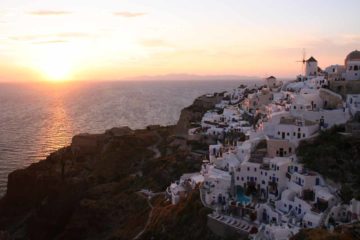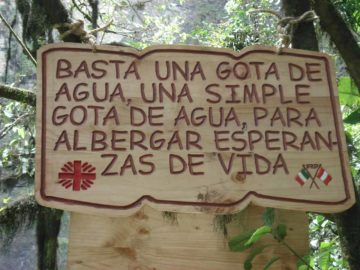About Cascadas del Monasterio de Piedra
The Monasterio de Piedra (Stone Monastery) was a natural park that featured countless waterfalls. In fact, we were so overwhelmed by the sheer number of waterfalls that were flowing throughout the park, that we ended up with waterfall fatigue at the end of our visit. Indeed, we thought of this place like a mini-Plitvice, where we’d encounter one waterfall after another. Some of the waterfalls (like the one you see pictured above) were so impressive that even if the park didn’t feature so many waterfalls, we could’ve been satisfied just with one or two of the major ones. Of course, overdelivering on waterfalls wasn’t the only thing this place had going for it. It also featured an extensive garden, a mirror lake flanked by red cliffs, deep and dripping caves, and let’s not forget the namesake monastery giving this place some historic credibiilty! It even had some playgrounds for the little ones to be occupied! This place seemingly had it all!
Thanks to the sheer number of waterfall sightings at Monasterio de Piedra, Julie, Tahia, and I wound up spending nearly four hours at the park (much longer than we had anticipated). Unfortunately, we had neither the time nor the energy to keep the visit going with a tour into the monastery here. Probably the biggest reason why we knew so little about this place going into this trip was that none of the major guidebooks adequately covered this place. It wasn’t in LP nor Rick Steves, and it only got a generic paragraph or two in DK with neither a photo nor a map. That said, we’ll describe how we did the visit (which pretty much followed the tourist map included with the admission, which numbered the sights in the order you should do the self-guided tour) just to give you an idea of what a typical waterfalling visit here might entail.
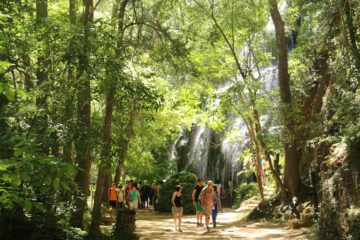
However, the self-guided tour had us continue walking upstream along the stream past the Lago de los Patos (Lake of the Ducks), then cross before the Cascada Trinidad, which had a graceful characteristic about it. Beyond the Trinity Waterfall, we then passed by a pair of grottos called the Gruta de la Pantera, Gruta de la Bacante, and Gruta del Artista. Just before climbing up the steps nearest to the last cave, we then spent some time at the lookout for the Cascada La Caprichosa, which apparently just about every visitor to this site was compelled to do given the size of this falls.

At the very bottom of the descent was the Cascada Iris. It appeared that the Fresnos and the Cascada Iris might have gotten some help from a little water channeling seeing how the watercourse seemed to be “well-behaved” in that the stream never crossed the footpath unless it was under a bridge or along a water channel. Indeed, speaking of water channels, this rare display of waterflow control seemingly defied Mother Nature’s normal unpredictable course of action, which was to sometimes flow right over these adjacent footpaths. Anyways, once we were at the base of Cascada Iris, we were at a junction where it seemed like we had a choice of where to go next, but sticking with the map, we next went to the Gruta Iris, which was a grotto that went behind the uppermost sections of the very tall and gushing Cola de Caballo (Horse’s Tail) Waterfall.
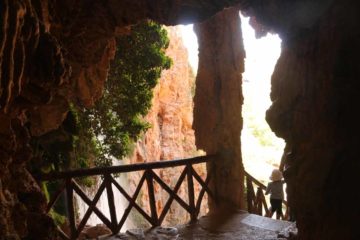
We then left the cave along a long tunnel that ultimately deposited us in a calm garden area. Keeping right along the stream, we then crossed a bridge where just on the other side of it was a mirador peering back at the entirety of the Cola de Caballo (which might be at least 60m or taller in height). Since the canyon at the base of the falls was confined, the waterfall’s mist had nowhere to go but back out towards the mirador so it could still get a little bit misty even though the mirador was a fair distance downstream from the waterfall itself.
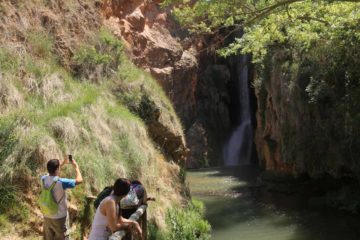
The Lago de Espejo stretch then started to give way to a garden area as it curved back around towards the trail we had walked earlier near the exit of the cave at the foot of the Cola de Caballo. Along the way, there was an old house that was said to be from the 1870s that was still in the process of being restored. There was also the Fuente del Señor, which was a spring. The next part of the trail involved some uphill walking, but before we had to do that, there was a Zona de Descanso (Rest Area) where there was a playground that thrilled our daughter while Julie and I got to relax for a little bit.

Finally, we passed before the Cascada Iris and followed the path past the Gruta de la Carmela then the lone Cascada Sombria before climbing back up past the Cuatro Calles area (where we could partially see the hotel and monastery exterior) before coming back to the park exit and quad area. Once in the quad area, we then paid more attention to the cafes and restaurants (for that well-earned lunch) across from the ticket office as well as the entrance to the monastery part of the park.
Since we didn’t do the monastery, we can’t comment more on it. But just the fact that we took four hours to visit just the natural part of the Monasterio de Piedra, and the map showed there was still a bit more to explore in the monastery part of the complex, we very easily could’ve spent an entire day here. In fact, this could be the reason why there was a hotel and spa here so it would be possible to experience this place at a more leisurely pace. We saw something similar to this at the Alhambra in Granada since that complex was so extensive that it probably made sense to spend the night just to more fully appreciate the place under more peaceful conditions.
Speaking of peaceful conditions, while the Monasterio de Piedra park was busy, it didn’t feel like an overwhelming crush like other popular tourist spots in Spain. In fact, it seemed like we were one of the few non-Spanish foreigners in the park, and I suspect this might have something to do with the relative lack of coverage from the major guidebooks of this place. Still, it was well known amongst the Spanish and tour bus routes so certainly this place was not like a hidden secret.
Related Top 10 Lists
No Posts Found
Trip Planning Resources
Nearby Accommodations
This content is for members only. See Membership Options.Featured Images and Nearby Attractions
This content is for members only. See Membership Options.Visitor Comments:
Got something you'd like to share or say to keep the conversation going? Feel free to leave a comment below...No users have replied to the content on this page
Visitor Reviews of this Waterfall:
If you have a waterfall story or write-up that you'd like to share, feel free to click the button below and fill out the form...No users have submitted a write-up/review of this waterfall



